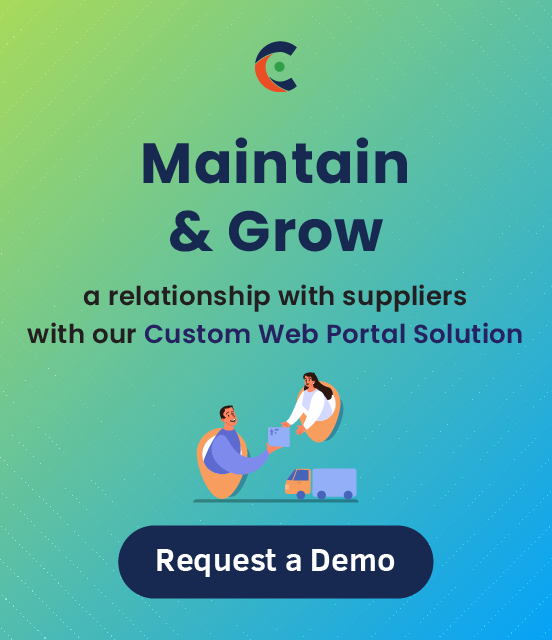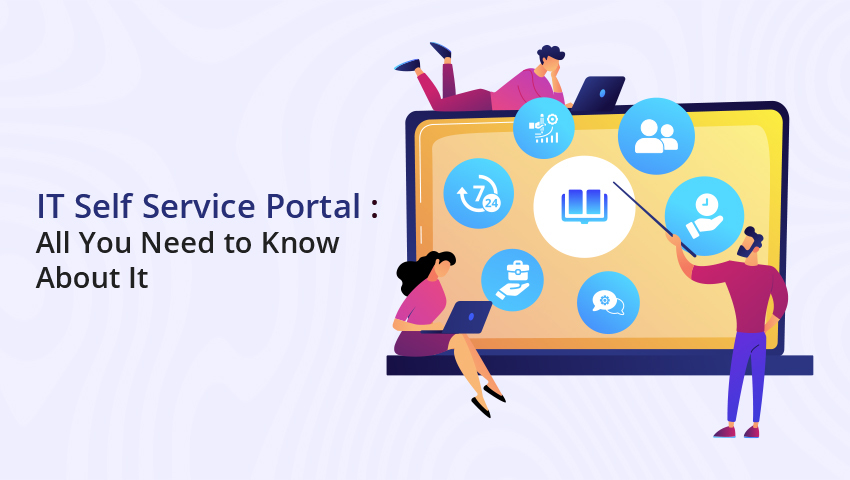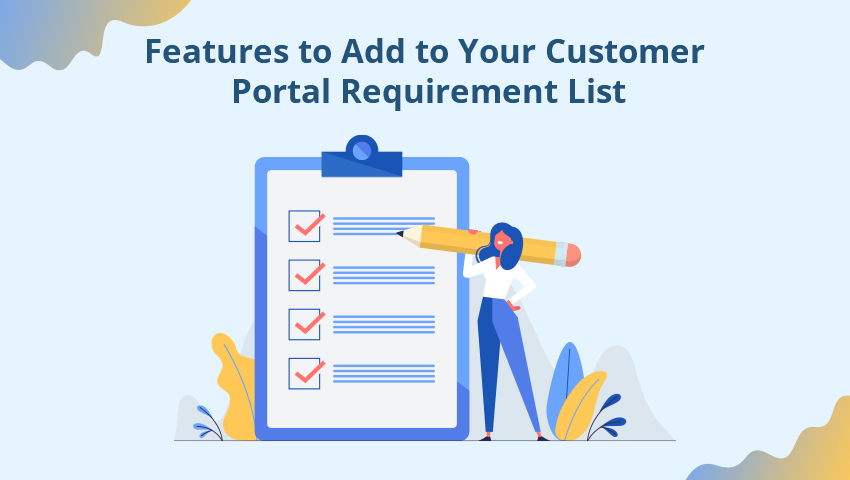Since the pandemic has turned every one to work remotely, the need for an online presence has increased. With that, it has become important for businesses to look for web portal software that will allow them to automate tasks, track operations, and significantly increase customer, employee, and partner engagement. But what type of web portal do you need? What will be the development cost? What factors affect the cost?
This article will cover web portal software, including types, development methods, functionalities, advantages, etc. Before that, let’s see what an online web portal is and how it differs from a website. Most people still use the names interchangeably as if it’s the same.
What is an Online Web Portal?
A web portal provides a single point of access to various information. You and users can consider it as a library of personalized and well-organized content consisting of company articles, products information, vendors and suppliers lists, and more.
A web portal software helps in search navigation, personalization, information sharing, notifications, etc. However, to carry out these activities and look at the content, users need access. They need a user account to log in. Once logged in, they can access information provided by you, i.e., a store owner. What makes a web portal convenient is that it collects information from various sources like CRM, CMS and presents it in one place. It reduces users’ efforts. For example, your team doesn’t have to juggle between systems to get customers’ details. Apart from accessing information, it even makes communication between teams easy.
Though the features of a portal look similar to that of a website, their purpose differs, and so do their characteristics. They are not interchangeable. While the website uses web pages that anyone can access, the web portal requires login credentials, and only authorized users can access it. The purpose of a website is to create a digital presence, whereas web portals provide relevant information to authorized users based on their roles.
Common Types of Web Portal Software
Online web portals help with personalization, document management, information tracking, collaboration, business intelligence, etc. As every business is unique, web portals are used in different ways. There are two main types: Horizontal and Vertical. Horizontal portals provide all the relevant information that users might require. Vertical, on the contrary, provides specific information only.
They are then bifurcated into various subtypes based on their target audience and purposes.
Customer Portal
This is for businesses that want to improve their customer support and build loyalty. Customer portals allow customers to place and track orders, generate tickets, activate/deactivate services, get personalized recommendations, manage their transactions, view the status of their query, and find solutions on their own.
Vendor Portal
It’s a solution for businesses having a vast number of third-party suppliers. This type of web portal software is used to communicate and share data with vendors. It makes vendor management easy. Vendors have the freedom to manage their accounts, proposals, orders, etc. Your staff can manage all the vendor-related activities such as sending invites, comparing proposals, viewing suppliers’ information all in one place.
Partner Portal
Industries such as travel, real estate, banking, logistics, or healthcare, often have to deal with multiple partners to get their work done. For instance, real-estate businesses have brokers and others to help them crack a deal. Partner portal helps businesses interact with their partners efficiently by giving them access to data, managing leads, viewing partner performance, speed onboarding, etc.
Affiliate Portal
This type of portal provides an attractive interface to affiliates. It allows them to manage custom links, channels, rewards, invoices, etc., saving your time and building long-lasting relationships.
B2B portal, B2C portal, membership management portal are a few of the other portal examples commonly used. However, the pandemic has forced businesses to implement new strategies, approaches, and digital tools. Thus, there are key portal types that are in demand. Let’s check them out!
Portals Gaining Popularity in 2021
A few web portal software types that are in demand are:
Knowledge Base Portal
This type of portal automates customer support. It lets you educate your customers and employees, support them, and improve customer understanding. A knowledge base consists of blogs, FAQs, guides, tutorials, user manuals, and other relevant information. It helps users find answers on their own.
Community Portal
Community portals help with brand building. Here, people come together to share their interests, suggest solutions, and help one another. For example, if you’re in the printing business, the community portal will allow your customers to discuss printing services, tools, methods, etc. If a new customer wants to try out Dye sublimation and is confused, other customers with an experience can share their insights. They can share tips, lists of dos and don’ts, and more. A community portal allows everyone to come together and share their thoughts. Since the pandemic, many people are using community portals, and hence, there’s a huge demand.
Self-Service Portal
As customers like doing everything on their own, there’s a huge surge for self-service solutions. This web portal software provides information related to products, services, and other business-related things. They allow users to handle their activities rather than wait for a support team. Self-service improves the customer service quality and relieves tech support teams from stress.
Customizable Portal
Custom portal development is the new trend! Gartner suggests that 85% of user interaction will start with self-service by 2022. But customer behavior keeps changing as technology advances. Hence, businesses are looking out for a customized portal that meets their business demands. A solution that can expand with the growing business is suitable for each user in the organization.
E-Learning Portal
E-learning is a new trend now, and so is the e-learning portal. An e-learning portal can provide access to various materials while allowing teachers, parents, and admin to handle their activities themselves. For instance, a parent can view their child’s progress report without contacting the teacher or asking the kid.
Corporations also use these kinds of e-learning portals for training employees and helping them grow.
To find out what other portals are in demand in 2021, check out this article – 5 Custom Portal Solutions to Consider in 2021.
Reasons to Have a Web Portal Software
Now that you know about the types of portals, you would have got a little idea of their benefits. However, just for clarification, here are a few arguments that will convince you to go for web portal software development.
Custom Business Logic
Features like role-based access, user authentication help you with a dedicated exchange of information. Configuration and personalization options further enable users to configure the portal as per their needs. Say a customer wants to know about the latest updates on logging in to the portal. They can configure the dashboard accordingly. A web portal software allows you to utilize the data to benefit you and the business.
Enhanced Collaboration
Third-party social sharing spaces make it easy for businesses to interact with one another. However, they don’t save time. You have to download the document and then upload it on the server. But, web portal software allows information to flow easily. For instance, a team can share the documents and work on them together without any extra effort.
Simplification of Operations
As the portal allows everyone to handle their activities themselves, it reduces the work of one person. For example, insurance agents don’t have to update customers’ details and documents every time. Customers can do it on their own by logging into the portal. The support team doesn’t have to waste time updating customers about their order or ticket status. They can work on something productive.
Better Security
Many businesses avoid third-party tools because of data theft. Also, there are limitations to what data you can share with a specific team or team member based on their roles. For example, you won’t give your intern access to the CRM. Even a small mistake in an invoice by them can create havoc. But you need to provide them with limited access to view customer details if not edit. A web portal software gives you that freedom with role-based access. Users can access the data and perform actions based on their roles.
Boost Customer Engagement
A web portal helps establish a strong relationship between businesses and customers with features like knowledge base, self-service, community support, ticket management, etc. As customers know what they are doing and can find their answers themselves, they become satisfied and loyal.
Centralized Management
To access different solutions like CRM, CMS, POS, a web portal provides a single access point. It connects every system and ensures users get everything they require in one place. You want to check a customer’s details; you can do so from the portal without logging in to the CRM.
About the features and other reasons to go for web portal software development.
How to Build a Web Portal Software
By now, I am sure you’re excited to build a web portal. And thus, in this section, we will see the steps involved in web portal development. Let’s proceed!
Create a Plan
This is the first thing you need to do. Think about your business and figure out the purpose of your portal and the target audience, whether it will be for users or suppliers. Don’t forget to research. Know what kind of solution your customers require, what features they expect, and what you should integrate. After thorough research, list down the features along with your target audience, objective, and other details.
Decide your Architecture and Design
After creating a plan and deciding on features, you need to decide the feel and look of your portal. It’s important as it reflects your brand. So, while creating the portal design, check the font and theme properly, focus on images, and don’t go on experimenting with too dull or gaudy shades. Balance it well!
Don’t forget to include the search option. The button positioning, check that too.
Start the Development
With plan and design in hand, the only thing left is to give developers a green signal. While developing, make sure that developers consider these elements – user-friendly navigation, payment integration, security, scalability, etc.
Test it Rigorously
This is when the QA team stamps the portal to be fit to deliver, only after testing each function and modules’ working several times using different approaches.
If your testing is successful, it will increase your portal users’ experience. It doesn’t stop there. The post-launch period is about maintenance. You need to ensure that the portal stays up-to-date with the changing customer requirements and development trends.
You also need to consider the portal development cost in the planning. Various factors affect the development process cost.
Factors Affecting the Development Cost
- Outsourcing or On-Premise
The first factor is to choose the right development partner. Generally, outsourcing costs less than on-premises. However, it can cost you a fortune if you choose a less reliable partner.
- Features
The features you decide to add to your portal affect the cost of the portal development process. The more complex the features are, the higher the cost.
- Developer’s Skills
An experienced development team will provide a quality solution though the cost would be higher. You can get the portal developed by a less experienced vendor. However, the quality and other glitches may cost you more.
- Elements to Include
The cost of web portal software will vary based on the components you want to include. Say, you may require multiple payment methods. For that, you will require third-party API integrations, which will increase the cost.
Hence, while researching, research thoroughly! Consider everything from your requirements to development factors. While we are on it, let me tell you how CRMJetty can help you in the process.
You can also check our case studies, portfolio, and client testimonials to get a better idea.
CRMJetty: An Ideal Web Portal Development Partner!
We have been serving this industry for 14+ years and know about the nooks and hooks of various industrial processes. Hence, we can help you identify if the requirements are suitable for your industry and the new trends in the market. For example, what new features are available, what you should add and what you shouldn’t. You get a one-on-one discussion with our industry experts! After deciding everything, our development team will start with the sprints, followed by the testing, of which you will be a part. Once the testing is done, we will train you on the portal’s working and be there for you whenever you require help!
A few reasons why CRMJetty would be the right choice:
- We provide ready-to-integrate and custom solutions. Whether it’s a few tweaks or one from scratch, we will be there for you.
- We analyze your requirements and, based on them, suggest the solution. Only when the customizations are required would we suggest and go the extra mile to make those changes.
- We follow the Agile methodology, which means there’s transparency at all stages.
- We have a track record of 70+ custom portal integrations.
And if you’re satisfied
All product and company names are trademarks™, registered® or copyright© trademarks of their respective holders. Use of them does not imply any affiliation with or endorsement by them.



![Web Portal Software – A Guide [2021 Edition] Web Portal Software – A Guide [2021 Edition]](https://www.crmjetty.com/wp-content/uploads/2021/09/Web_Portal_Software_-_A_Guide_2021_Edition.jpg)




